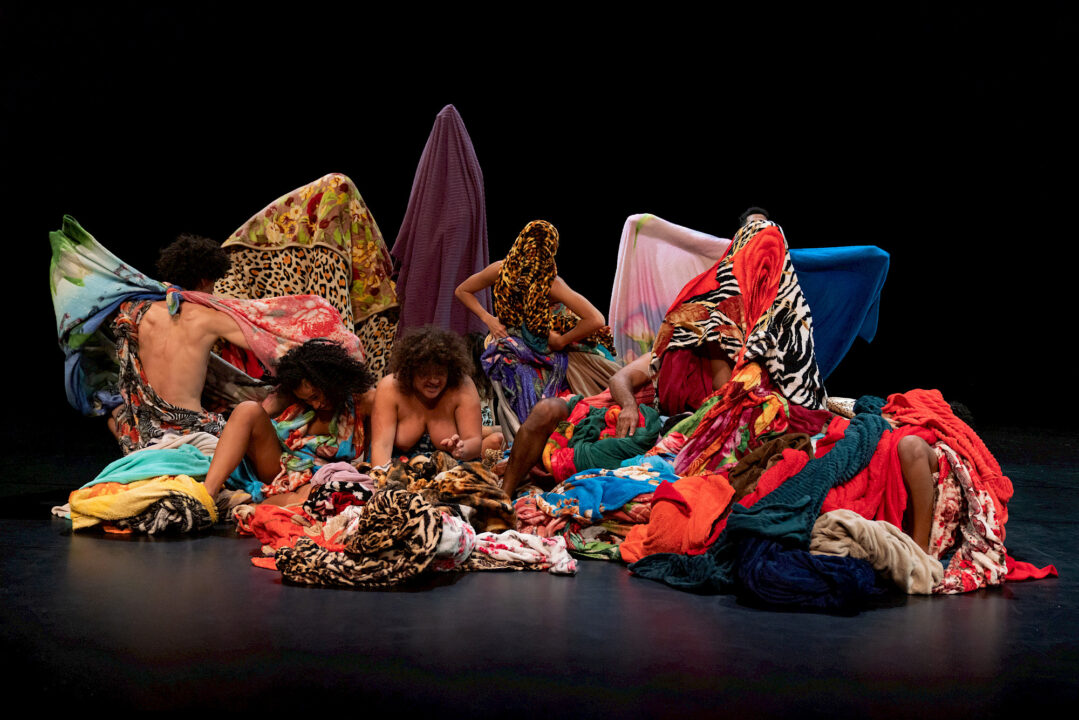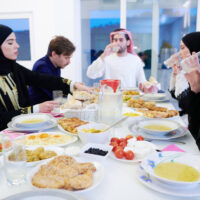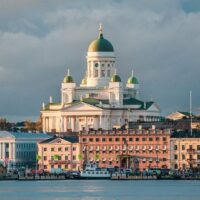”They say when we’re all in the same space listening together
our heartbeats might end up synchronizing.
But our breathing will not, our breathing will stay polyrhythmic.
They say listening might be the most complex of all human behaviours.
To listen is a state of tension. ” Kate McIntosh
Brussels (Brussels Morning) – A program full of dance and theatre thought of as a collection of songs on a record.
As it is now a solid tradition each year in May the KFDA fills several cultural venues in Brussels. This time it even fledges beyond the communal cocoon with one of the artists, choreographer Lia Rodrigues from Brazil, bringing its latest creation “Encantado” on the new stage of the cultural centre De Factorij in the neighbouring township of Zaventem.
Brussels Morning asked one of the directors of the festival, Daniel Blanga Gubbay, to guide us through the history and design of the festival that is now having its 27th edition between May 7 and 28.
In the program we can read the festival serves to rethink the geography of Brussels, capital of Belgium and of Europe?
Yes. The main role of the festival in itself is to change the way in which people circulate within cultural institutions. Back in the 90’s, when the festival was launched by the late Frie Leysen, not much interaction existed between the public going to French speaking cultural institutions and the public of the Flemish theatres and cultural centres. The idea was to have one festival for both to obtain a kind of nomadic experience whereby the public of both linguistic communities circulates within the city and its cultural institutions. Since then the city became very multi-layered with several communities that offer today a kind of kaleidoscopic experience of many communities living in the city. Many new waves of immigration have now enriched the demographic texture of the city itself. This is something which has been present for us in the project when we took the lead of the festival, reflecting on which kind of institutions we are working with when composing the KFDA. On top of collaborating with our historical partners we look as well now how to involve new partners in order to recognise the complexity of the geography of the city.
On the one hand the physical geography of the city was important because the festival at the very beginning was more restricted to the Brussels pentagon. Now more and more we try to understand how to recognise that there is no one centre and a periphery, but a Brussels made of different, multiple centres and communities.
We went out of the centre by organizing the festival centre in Molenbeek or by having partners such as De Kriekelaar in Schaarbeek and Jacques Franck in Sint Gillis.
We always research how to break down the ritual habits of people in joining other parts of the capital.
Your Program is aimed to tackle the perspectives of the visitors on the city and the world?
For us the life aspect is inherent to the art forms we bring, theatre and dance mainly, but it is also about the lifeness of the experience itself. How this life experience creates a very specific idea on how we come all together to experience something together in the same venue and how, by doing so we create a temporal community while looking together at something. This is very different from visiting e.g. exhibitions which offers a more solitary experience. We are experiencing not only what happens on stage but we are experiencing this communality of being together with others who are living the same experience with us at the same time in the same scenery which is something very specific, at the core of the performing arts experiences.
This year the overall theme is “Politics of music”. Could you elaborate on this?
The festival itself is not thematic but we tried to understand what were the topics that are knowable from the program. The metaphor of music came from the same idea as the metaphor of the city. How do you see the space where actually we are very often literally together? In music there’s a kind of coexistence of instruments, of voices and of different rhythms that sometimes are complying but sometimes also are in a kind of conflicting presence. That is what music renders so beautiful, all these differences that are part of it. It renders a kind of space, a metaphor for being together in a way that is not simply a unity harmonized, creating one image, but a space that brings as well the frictions and the diversity. How a city like Brussels has this potential as well.
Music as a way of getting to dialogue?
Music has much to do with personal identity but it has also this possibility of going beyond the defined personal identity, becoming a tool to create a kind of shared space of dialogue and this is indeed what happens when playing together. One of the projects we are presenting is from Christoph Marthaler, “Aucune Idée”, which describes the relationship between 2 neighbours in an apartment who are experiencing a complete lack of communication with each other, except for the moment when they play together. This is really “good” music and shows us how music creates shared spaces of dialogue through a different language.
Another project is from Chassol, a French composer of the new jazz scene. He is very interested in the different influences that exist within music. We commissioned him to create a new album in Brussels because his technique of composition always starts from the way in which people speak. He records people speaking and then he traces the hidden harmonies and melodies that exist within the voices of people. And so in Brussels he started recording people that were speaking several languages trying to translate this into music. Now we are presenting 3 concerts of his new creation and how he was involved with the people with whom he worked in Brussels. It brings a kind of polyphonic portrait of the city where you hear all these voices and how they can be translated into music. He composes a kind of portrait of the city which does not only speak of one single identity but where all these identities are present in something which is bigger than simply one.
What is going to happen with this creation beyond Brussels?
Our work at the festival is always to support artistic creation. We accompany the artist in creating a new project. So in the case of Chassol its title is “Chou” , Chou de Brussels. Chou is the French word for cabbage but also refers to how cabbages have this fractal structure. When one starts looking at the tiny parts of the cabbage under a microscope one finds back the shape of the cabbage itself. The micro element reproduces the shape of the whole and for Chassol it was a kind of a metaphor of how each identity holds a kind of complexity and how this is also the case for the city. Each of us has an image of how the city is. It is not one of these that represents the city exclusively but many together. Chassol starts with this work a world tour so that we can bring the sound of Brussels also to other cities. but, with his experience of touring, we decided to open a kind of small tour in Brussels already. It is also a premiere for us to bring the same piece to several venues in Brussels: we start in the AB with whom we are coproducing the project and then on the second day it is going to be in La Monnaie, the opera house. This is very important to us as it will allow a lot of young people that follow Chassol to enter the opera house. On the third day it’ll be in the Archiduc. Three venues that are highly connected to music in the city.
Polyphony but also multiple rhythms? Multiple ways of understanding a city and its history?
We very often think of history through one rhythm that is made of acceleration or deceleration. In the festival we started thinking through the rhythm of polyphony which is a very specific form of rhythm where there are several rhythms that are superposed in a conflicting way. You can have e.g. 4 against 5 voices or 7 against 11. It demands to be trained how to perform it. What is interesting is that there is always one rhythm that is dominant, one which is easier to be heard, and then you have the other rhythms that ask for a special kind of attention to be heard as our ear tends to simplify the listening and just likes to focus on what is perceived as the dominant rhythm.
The idea of Polyrhythm is recognising there is never one rhythm only but that somewhere we are living in a superposition of several rhythms in the same way as there is not only one narrative in history but always several narratives. Very often we reproduce the idea that there is a dominant narrative which is the one that is the most exposed or the one we are listening to the most. But we have to acknowledge the complexity of conflicting narratives , conflicting history that might coexist.
In the Polyrhythmic school, a workshop brought by Brussels based artist Kate McIntosh, people are being thought to play a big drum in a way to open ourselves, to train ourselves to listen to what is less heard.
And this is also part of the genetics of the festival: we are very much in contact with artists whose main purpose is to reveal histories that have been individualised. How can we expose or recognise things that have been neglected? This is particular to a lot of artists.
Should politicians follow these kinds of workshops?
Indeed. How do we fight against simplification? This is at the core of the festival. How do we claim the importance of complexity even if it demands more time to listen to it, to understand or maybe not to understand. How do we recognise that there does exist a kind of tendency to simplify the discourse and that this simplification very often is reducing our narratives to one.
We work a lot in breaking and sharing with the Brussels audience projects that have never been presented in Europe. Mark Teh e.g. is a collective based in Kuala Lumpur , Malaysia that works a lot on the way history books have been written. They start from the context of the Malaysian independence war and the role of communist fighters in this war. The way in which ordinary citizens had to be virtualised. It is an incredible poetic performance in which through music and storytelling they open up the importance of recognising the complexity of history beside what is politically important to tell at this moment.
Another project that I would suggest is the one of the company Fanny and Alexander. It is performed in the Senate of Belgium. A one-time experience because normally no (artistic) shows are produced in the Senate. The project starts from the interviews that Holocaust survivor Primo Levi gave during his life. When you enter the senate as a spectator you’ll get a sheet of paper with a series of questions you can address at the podium. While sitting in the hemicycle of the Senate you can raise your hand and ask one of these questions. And the actor who is interpreting Primo Levi gets directly in his ear the original voice of Primo Levi answering the question. So the actor is really interpreting Primo Levi with all the hesitations and micro gestures that Levi used to have. These questions remain incredibly interesting because somehow even if they are very specific to the content of the Shoah, they also resonate very strongly today. How is it possible that Europe arrived at the possibility of disconnecting from its citizens? These questions also address how you can say that what you are saying is true. These were also very confronting questions for Primo Levi.
A third project that I would like to highlight is the one of Brazilian Lia Rodrigues “Incantado”, a text performance. She always addresses the way how dance and body based movements can speak about the way in which we live together in a society. An extremely powerful project!
The project of Jelena Juresa, “Aphasia” is another project that invites a kind of immersive experience whereby her performance reconstructs an evening in a nightclub, in a post-war region some 30 years after, where a woman recognizes the DJ as being a war criminal by comparing his movements then and today. Very interesting as she speaks about polarization and the way in which narratives are reduced, polarized. How can we create space to allow complexity?
Is this also what the European project of integration is about?
I definitely think European institutions helped to give complexity a place but I am not an expert in how this works in practice.
With these concluding words of Daniel Blanga Gubbay we can only warmly invite you to go to one of these performances, reminding us that a city and by extension all communities need the creative power of visual language and metaphors in particular to be apprehended and understood as a source for well thought out action.
Program and tickets to be found on www.kfda.be.



